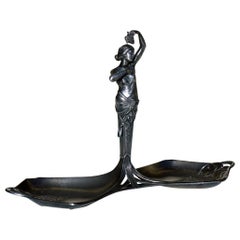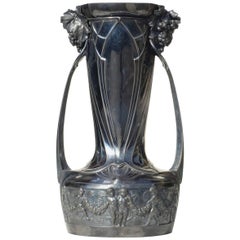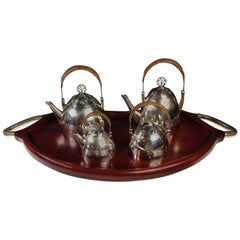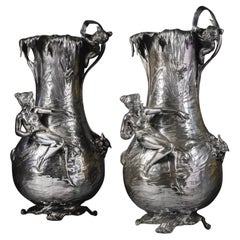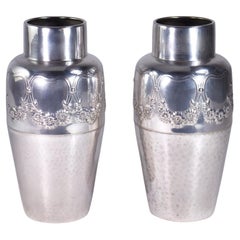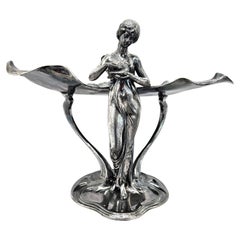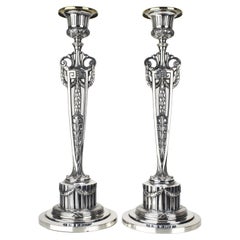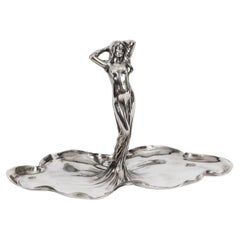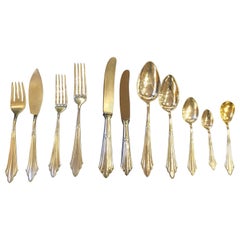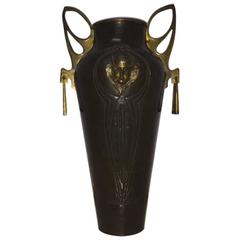Albert Mayer Wmf
Albert Mayer WMF Art Nouveau Early 1900 Silver Metal ware Female Figure
By Albert Mayer, WMF Württembergische Metallwarenfabrik
Located in Brescia, IT
Original early 1900
Excellent condition
"WMF" mark impressed.
Category
Early 20th Century German Art Nouveau Figurative Sculptures
Materials
Metal
$1,781
H 9.85 in W 15.75 in D 5.52 in
Early 19th Century WMF Albert Mayer Art Nouveau Jugendstil Big Silver Metal Vase
By WMF Württembergische Metallwarenfabrik
Located in Brescia, IT
Art Nouveau Big Vase
Albert Mayer
WMF
Germany, 1900-1910
Silver metal with a brass removable vase
Category
Antique Early 19th Century German Art Nouveau Vases
Materials
Silver Plate
$5,343
H 27.56 in W 14.97 in D 14.18 in
Art Nouveau WMF Silver Plate Tea and Coffee Service Designed by Albert Mayer
By Albert Mayer, WMF Württembergische Metallwarenfabrik
Located in Austin, TX
Albert Mayer for WMF and retailed by Casa Costa, Argentina.
The Art Nouveau set consists of a coffee pot
Category
Antique Early 1900s German Jugendstil Serving Pieces
Materials
Silver Plate
$4,500 / set
H 9 in W 28.5 in D 16 in
Two Large WMF ‘Art Nouveau’ Silverplated Vases, Designed by Albert Mayer
By WMF Württembergische Metallwarenfabrik
Located in Brighton, West Sussex
Two Large ‘Art Nouveau’ Silverplated Pewter Vases, Designed by Albert Mayer For WMF And Supplied To
Category
Antique Early 1900s German Jugendstil Vases
Materials
Silver Plate, Pewter
$37,789
H 23.63 in W 11.82 in D 11.03 in
Pair of W.M.F. Plaques Signed Albert Mayer, Art Nouveau Period, Germany
By Albert Mayer, WMF Württembergische Metallwarenfabrik
Located in Buenos Aires, Buenos Aires
Pair of W.M.F. plaques signed Albert Mayer (1867-1944). Art Nouveau period, Germany, circa 1900.
Category
Antique Early 1900s German Art Nouveau Decorative Art
Materials
Metal
$24,000 / set
H 29.53 in W 20.48 in D 1.58 in
Early 1900 Century WMF Albert Mayer Art Nouveau Silver Metal Vase _ set of 2
By WMF Württembergische Metallwarenfabrik
Located in Brescia, IT
WMF vases
Germany, 1900-1910
Silver metal Jugenstil Vases
Excellent condition.
WMF mark under the
Category
Antique Early 19th Century German Art Nouveau Vases
Materials
Silver Plate
$1,424 / set
H 9.06 in Dm 4.73 in
WMF Art Nouveau Jugendstil Silver Plate Centerpiece Card Tray, Germany, c. 1910
By Albert Mayer, WMF Württembergische Metallwarenfabrik
Located in London, GB
, designed by Albert Mayer who was head of WMF’s studios at the end of the 19th century and up to 1914.
The
Category
Vintage 1910s German Art Nouveau Centerpieces
Materials
Silver Plate
$3,711
H 8.39 in W 11.7 in D 8.67 in
Antique Candlesticks Empire Pattern by WMF Art Nouveau Silverplated
By WMF Württembergische Metallwarenfabrik
Located in Bad Säckingen, DE
designed by the famous German artist Albert Mayer and produced by the WMF company, which is renowned for
Category
Antique 1890s German Empire Candlesticks
Materials
Silver Plate, Pewter
$1,234 Sale Price / set
20% Off
H 11.82 in Dm 4.49 in
Antique WMF Silver Plated Sweets / Visiting Card / Key/ Tray Early 20th Century
Located in London, GB
of Albert Mayer the WMF studio was influenced by the art nouveau style. The product range was
Category
Antique Early 1900s German Art Nouveau Sheffield and Silverplate
Materials
Silver Plate
$1,687
H 8.67 in W 13.59 in D 6.5 in
Recent Sales
Complete Silverware Set by WMF in Art Deco Box
By WMF Württembergische Metallwarenfabrik
Located in Oakland, CA
“Perfect Hard Silver Plating”.
In 1910, under the art direction of Albert Mayer, WMF became famous for
Category
Vintage 1930s German Art Deco Tableware
Materials
Silver Plate
Large Exhibition Quality Copper and Brass Vase Designed by Albert Mayer
By WMF Württembergische Metallwarenfabrik, Albert Mayer
Located in London, GB
Designed by Albert Mayer, for W M F Wurttembergische Metallwaren Fabrik.
A large exhibition
Category
Antique Early 1900s Jugendstil Vases
Materials
Copper, Brass
Art Nouveau flower pot with a mermaid designed by Albert Mayer for WMF, 1898.
By WMF Württembergische Metallwarenfabrik
Located in Antwerp, BE
An Art Nouveau flower pot with mermaid.
Designed by Albert Mayer( 1867-1944) for WMF
Category
Antique 19th Century German Art Nouveau Vases
Materials
Britannia Standard Silver
H 12.6 in W 11.82 in D 10.63 in
WMF Art Nouveau Claret Jug c1900
By WMF Württembergische Metallwarenfabrik
Located in Tunbridge Wells, GB
Heading : Albert Mayer for WMF silver plated Art Nouveau green glass claret jug.
Date : c1900
Category
Antique Early 1900s German Art Nouveau Glass
Materials
Blown Glass
19th Century German WMF Silver Plated Casket / Jewelry Box
By WMF Württembergische Metallwarenfabrik
Located in London, GB
direction of Albert Mayer the WMF studio was influenced by the art nouveau style. The product range was
Category
Antique 1890s German Sheffield and Silverplate
Materials
Silver Plate
19th Century WMF Art Nouveau Silver Plated Centrepiece Cranberry Glass
By WMF Württembergische Metallwarenfabrik
Located in London, GB
direction of Albert Mayer the WMF studio was influenced by the Art Nouveau style. The product range was
Category
Antique 1890s German Art Nouveau Sheffield and Silverplate
Materials
Silver Plate
H 15.75 in W 14.57 in D 10.63 in
Early 20th Century Victorian Silver Plated WMF Shell Folding Biscuit Box
By WMF Württembergische Metallwarenfabrik
Located in London, GB
companies in London, Warsaw and Vienna opened up export markets.
Under the direction of Albert Mayer the
Category
Antique Early 1900s German Victorian Sheffield and Silverplate
Materials
Silver Plate
H 10.63 in W 9.45 in D 5.91 in
19th Century WMF Art Nouveau Centrepiece Jade Green Glass
Located in London, GB
and Vienna opened up export markets.
Under the direction of Albert Mayer the WMF studio was
Category
Antique 1890s German Art Nouveau Sheffield and Silverplate
Materials
Silver Plate
Edwardian Britannia John Dory Fish Meat Platter Serving Tray by W.M.F
By WMF Württembergische Metallwarenfabrik
Located in Van Nuys, CA
"WMF" (or "W.M.F.")
Under Albert Mayer's direction, WMF embraced Art Nouveau and expanded
Category
Vintage 1910s German Edwardian Serving Pieces
Materials
Metal
WMF Silver Plated Centrepiece / Bowl, Original Crystal Liner, circa 1900
By WMF Württembergische Metallwarenfabrik
Located in Bath, GB
for the famous WMF manufacturer ( WURTTEMBERGISCHE METALLWARENFABRIK). Under the direction of Albert
Category
Early 20th Century German Art Nouveau Decorative Bowls
Materials
Silver Plate
Fabulous WMF German Silver Plate Coffee Service, 1930s
By WMF Württembergische Metallwarenfabrik
Located in Oakland, CA
direction of Albert Mayer, WMF became famous for its Art Nouveau style and established companies for world
Category
Vintage 1930s German Art Deco Tea Sets
Materials
Metal
Spectacular German WMF Silverplate Art Nouveau Tea Coffee suite
Located in Oakland, CA
"Perfect Hard Silver Plating".
In 1910, under the art direction of Albert Mayer, WMF
Category
Early 20th Century Tea Sets
Materials
Bronze
Secessionist Silver Plated Basket
By WMF Württembergische Metallwarenfabrik
Located in Essex, MA
of Albert Mayer the WMF studio was influenced by the art nouveau style. The product range was
Category
Early 20th Century German Arts and Crafts Centerpieces
Art Nouveau Polished Brass Champagne Cooler
By WMF Württembergische Metallwarenfabrik
Located in Oakland, CA
. “Trophy” handles add to the style. This piece designed by Albert Mayer for the WMF Company of Germany is
Category
Vintage 1920s German Art Nouveau Barware
Materials
Brass
People Also Browsed
Art Nouveau Guimard Chandelier
By Hector Guimard
Located in Rebais, FR
Art Nouveau Guimard chandelier with nickel finish.
Category
21st Century and Contemporary French Art Nouveau Chandeliers and Pendants
Materials
Bronze
Striking Art Nouveau Ceramic and Bronze-Mounted Vase in Victor Horta Style
By Victor Horta
Located in Lisse, NL
Top condition and pure elegance Art Nouveau vase.
For the collectors of museum quality and condition Art Nouveau ceramics. This stunning Art Nouveau vase is decorated with the mos...
Category
Early 20th Century European Art Nouveau Vases
Materials
Bronze
$2,849
H 10.75 in W 5.25 in D 4.4 in
Fratelli TOSO Rare Table Lamp / Night-Light, 1900
By Fratelli Toso
Located in Saint-Amans-des-Cots, FR
Table Lamp / Night-Light by Fratelli Toso, Venice, Italy, c. 1900. Rare in this size, this exquisite table lamp, or night-light, is a stunning example of Venetian craftsmanship by th...
Category
Antique Early 1900s Italian Art Nouveau Table Lamps
Materials
Bronze
Wonderful French Lady Figure Art Nouveau Ormolu-Mounted Gilt Bronze Crystal Vase
Located in Roslyn, NY
Wonderful French lady figure Art Nouveau ormolu-mounted gilt bronze crystal vase
Measures: 11" tall.
Category
Vintage 1930s French Art Nouveau Vases
Materials
Crystal, Bronze
$1,695
H 11 in W 2.5 in D 2.5 in
Bentwood rocking chair attr. Thonet, late 19th century
By Thonet
Located in View Park, CA
A bentwood rocker attributed to Thonet, late 19th or early 20th century. Featuring art nouveau whiplash curves and real wicker caning. Made in Poland (possibly at the Radomsk Thonet ...
Category
Antique Late 19th Century Polish Art Nouveau Rocking Chairs
Materials
Wicker, Bentwood
Revernay French Art Deco Stoneware Bowl, 1920
By Revernay Sarreguemines Digoin
Located in Saint-Amans-des-Cots, FR
French Art Deco stoneware bowl on pedestal by REVERNAY (Digoin), France, 1920s. Height : 12.5cm - 5 inches, Diameter : 21.2cm - 8.3 inches. Marked "Revernay 160 3" under the base (se...
Category
Vintage 1920s French Art Deco Decorative Baskets
Materials
Stoneware
ZENITH 1930 Art Deco French Enameled Travel-Purse Watch In .900 Sterling Silver
By Zenith
Located in Miami, FL
A travel-purse watch designed by Zenith France.
This is a beautiful and very rare travel-purse watch, created during the art deco period by the Swiss watchmakers company of Zenith,...
Category
Vintage 1930s Swiss Art Deco Table Clocks and Desk Clocks
Materials
Silver, Sterling Silver, Enamel, Steel
$8,950
H 1.51 in W 2.28 in D 0.55 in
Daybed by Jacques Adnet Black Stitched Leather and Brass, France 1950
By Jacques Adnet
Located in Miami, FL
Daybed by Jacques Adnet black stitched leather and brass
France circa 1950
Excellent condition, wear consistent with wear and use
Upholstered with black leather
Available to view in...
Category
Mid-20th Century French Mid-Century Modern Daybeds
Materials
Brass
Loetz For Boudon And Klur Ruby Papillon Glass And Gilt Metal Mounted Vase
By Loetz Glass
Located in Dallas, TX
Loetz For Boudon And Klur Gilt Metal Monted Glass Vase. A highly sought after vase culminating the zenith of Loetz and the Art Nouveau design.
Czech Republic
Circa 1900
Rubin Ruby P...
Category
Antique Early 1900s Czech Art Nouveau Vases
Materials
Metal
$5,500
H 10.5 in W 8 in D 5 in
Art Deco Theater Terracotta Wall Mirror by Gmundner Keramik, Austria, 1930s
By Gmundner Keramik
Located in Vienna, AT
A charming wall-mounted mirror from the 1930s, crafted by Gmundner Keramik in Austria. The mirror features a shield-shaped ceramic / terracotta frame with a beautiful turquoise mint ...
Category
Mid-20th Century Austrian Art Deco Wall Mirrors
Materials
Ceramic, Pottery, Terracotta
$1,100
H 14 in W 12 in D 2 in
Swedish Chaise Lounge, Circa 1900’s
By Adolf Loos
Located in Turners Falls, MA
Swedish Chaise Lounge, circa 1900’s. Stained wood. Saber legs and carved bolster details.
Category
Early 20th Century Swedish Art Nouveau Chaise Longues
Materials
Upholstery, Mahogany
Pair of Jean Perzel Attributed 1940s Gilt Iron Wall Sconces
By Atelier Jean Perzel
Located in Sharon, CT
A pair of very large (27.5 inches high-exclusive of globes) Gilded Cast Iron (21 lbs. each) Wall Sconces. Not signed or otherwise marked.
Category
Vintage 1940s French Art Deco Wall Lights and Sconces
Materials
Iron
Tall Emile Galle Art Nouveau Botanical Carved Cameo Vase
By Émile Gallé
Located in Dallas, TX
Tall Emile Galle Art Nouveau Botanical Carved Cameo Vase
Carved and acid etched multilayered glass
Circa 1900 Art Nouveau
Signed: “Galle”
Height: 15.75 Inches
Diameter: 3.75 Inches
C...
Category
Antique Early 1900s French Art Nouveau Vases
Materials
Art Glass
Elegant Brass and Copper Art Nouveau Candlestick by Carl Deffner Germany 1910s
By Carl Deffner
Located in Malmö, SE
An elegant counterweight Art Nouveau / Jugendstil candlestick with amazing patina. Model 518 in the 1902 Deffner Catalog.
Made from brass and copper by manufacturer Carl Deffner in E...
Category
Early 20th Century German Art Nouveau Candlesticks
Materials
Brass, Copper
$895 / item
H 4.49 in W 9.45 in D 3.78 in
19th Century French Ormolu and Crystal Drinks Set
Located in London, GB
A drinks set of the Napoleon III Period
The ormolu rectangular frame, rising from swept feet, with a running arcaded gallery, fitted with a mirror plate base houses a suite of fou...
Category
Antique 19th Century French Napoleon III Crystal Serveware
Materials
Crystal, Ormolu
19th Century Antique Italian Carved Walnut Bench by Valentino Besarel Ca 1870
By Valentino Besarel
Located in Encinitas, CA
Magnificent walnut hand-carved bench attributed to master artist Valentino Besarel (b. July 29 1829, d. Dec 11 1902) of Venice, Italy.
Renaissance Revival.
High quality; soft, fi...
Category
Antique Late 19th Century Italian Baroque Benches
Materials
Walnut
$6,000 Sale Price
20% Off
H 44 in W 42 in D 22 in
Get Updated with New Arrivals
Save "Albert Mayer Wmf", and we’ll notify you when there are new listings in this category.
Albert Mayer Wmf For Sale on 1stDibs
Find many varieties of an authentic albert mayer wmf available at 1stDibs. A albert mayer wmf — often made from metal, silver and silver plate — can elevate any home. There are many kinds of the albert mayer wmf you’re looking for, from those produced as long ago as the 19th Century to those made as recently as the 20th Century. A albert mayer wmf, designed in the Art Nouveau, Art Deco or Arts and Crafts style, is generally a popular piece of furniture. Many designers have produced at least one well-made albert mayer wmf over the years, but those crafted by WMF Württembergische Metallwarenfabrik, Albert Mayer and WMF Ikora are often thought to be among the most beautiful.
How Much is a Albert Mayer Wmf?
The average selling price for a albert mayer wmf at 1stDibs is $7,250, while they’re typically $270 on the low end and $1,000,000 for the highest priced.
More Ways To Browse
Wmf Decanter
Wmf Figural
Wmf Secessionist
6 Piece Silverplate Coffee Tea Service
German Biscuit Box
Art Nouveau Mermaid Vase
Wood Nude Torso
Wood Oratory
Wood Painted Decorative Columns
Wood Priest
Wood Wash Stand
Wooden Desk Boxes
Wooden Throne
Wrought Iron Headboard
Young French Nude
Young Manufacturing Burl
Zenith Console
16th Century Bed
